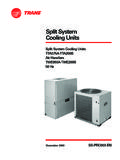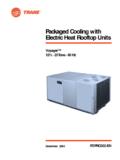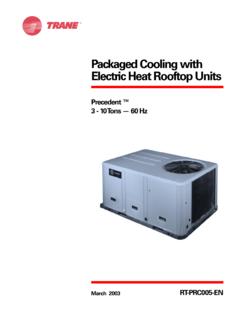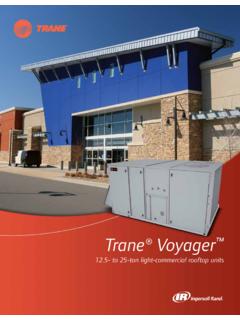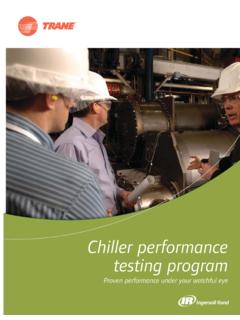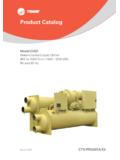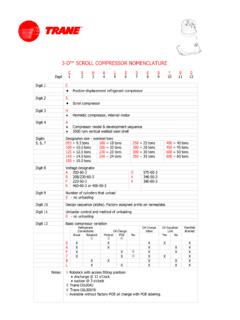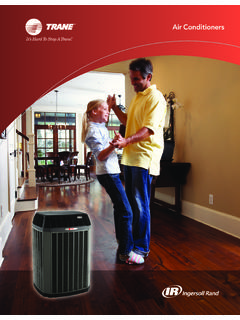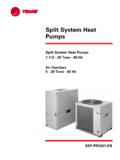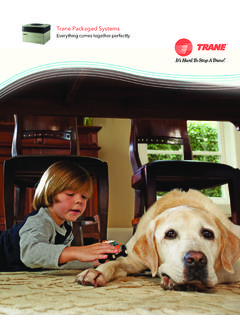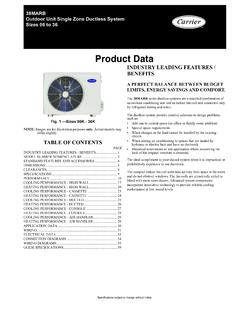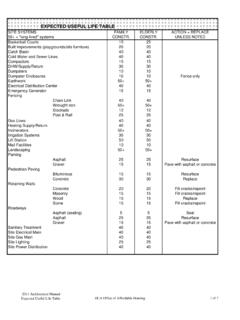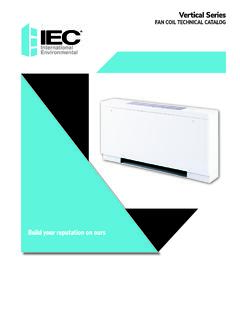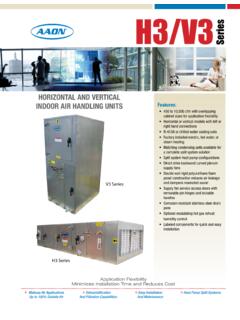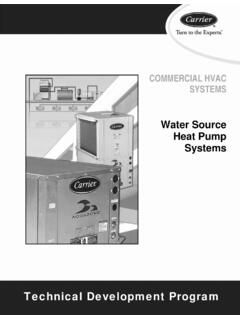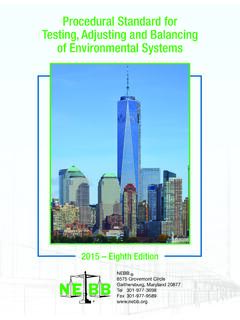Transcription of Packaged Terminal Air Conditioner - Trane
1 Installation,Operation, and MaintenanceSeptember 2006 PTAC-SVX01C-ENPTEE070/PTHE070 (7,000 Btuh)PTEE090/PTHE 090 (9,000 Btuh)PTEE120/PTHE120 (12,000 Btuh)PTEE150/PTHE150 (15,000 Btuh) Packaged Terminal Air Conditioner2 PTAC-SVX01C-ENTable of Contents .. 2 Model Number Description.. 3 General Information.. 4 Pre-Installation .. 6Ta b l e 1 . Minimum interior and exterior projections .. 6 Table 2. Minimum clearances and projections .. 7 Receiving and Handling .. 7 Unit Dimensions.. 8 Installation.. 10 Energy Management System .. 19 Operation.. 21 Sequence of Operation .. 21 Maintenance .. 30 Refrigeration System Service .. 31 Brazing.. 32 Evacuation.. 33 Cooling Performance Test .. 35 Ground Test.. 37 Table 27. Thermistor indoor coil resistance.. 38 Diagnostics .. 41 Table 28. Diagnostic codes .. 41 Table 29.
2 Latching diagnostics, reset required .. 41 Table 30. Automatically resetting diagnostics.. 41 Troubleshooting .. 41 Wiring Diagram.. 45 Warranty.. 50 Full 1st Year Warranty .. 50 Full 2nd - 5th Sealed System Warranty.. 50 Limited 2nd through 5th Year Functional Parts Warranty 50 Table of ContentsPTAC-SVX01C-EN3*All heat pump units must have electric 8 Main Power Supply1 = 230-208V/60Hz/1phase2 = 265V/60Hz/1phase4 = 115V/60Hz/1phase ( hydronic Only)Digit 9 Electric Heat Capacity*U = Universal Heater (Heater kW determined by power cord, see Accessories Section)W = hydronic (ships with no front cover & no electric heater)Digit 10 Unit FeaturesA = StandardC= Corrosion ResistantD = Internal Condensate PumpDigit 11 Minor Design SequenceModel Number DescriptionP T E E 0 9 0 1 * A A 1 2 3 4 5 6 7 8 9 10 11 Each Packaged Terminal Air Conditioner /Heat Pump is assigned a multiple-character alphanumeric model number that precisely identifies each unit.
3 An explanation of the identification code that appears on the unit nameplate is shown model number helps owner/operator, installing contractors, and service technicians to define the operation, components and options for a specific unit. Refer to the model number printed on the equipment nameplate when ordering replacement parts or requesting and discharge grilleElectric heaterIndoor FanDisplay ModuleOutdoor fanWall sleeveOutdoor grilleOutdoor coilRotary compressorPower cord coverplate (not shown)Power cordControl boxIndoor coilDigits 1, 2 Packaged Terminal Air ConditionerDigit 3 Product TypeE = Air Conditioner with auxiliary heatH= Heat PumpDigit 4 Development SequenceE = Fifth Development SeriesDigit 5, 6, 7 Unit Cooling Capacity070 = 7,000 Btu090 = 9,000 Btu120 = 12,000 Btu150 = 15,000 BtuGeneral Information 2005 American Standard Inc.
4 All rights reservedPTAC-SVX01C-ENNOTICE:Warnings and Cautions appear in appropriate sections throughout this manual. Read these Indicates a potentially hazardous situation which, if not avoided, could result in death or serious Indicates a potentially hazardous situation which, if not avoided, may result in minor or moderate injury. It may also be used to alert against unsafe Indicates a situation that may result in equipment or property-damage-only of ManualNote:One copy of this document ships with each unit and is customer property. It must be retained by the booklet describes proper installation, operation, and maintenance procedures for PTACs. By carefully reviewing the information within this manual and following the instructions, the risk of improper operation and/or component damage will be is important that periodic maintenance be performed to help assure trouble free operation.
5 A maintenance schedule is provided at the end of this manual. Should equipment failure occur, contact a service organization with qualified, experienced HVAC technicians to properly diagnose and repair this Environmental Concerns!Scientific research has shown that certain man-made chemicals can affect the earth s naturally occurring stratospheric ozone layer when released to the atmosphere. In particular, several of the identified chemicals that may affect the ozone layer are refrigerants that contain Chlorine, Fluorine and Carbon (CFCs) and those containing Hydrogen, Chlorine, Fluorine and Carbon (HCFCs). Not all refrigerants containing these compounds have the same potential impact to the environment. The manufacturer advocates the responsible handling of all refrigerants including industry replacements for CFCs such as HCFCs and HFCs.
6 Responsible Refrigerant Practices!The manufacturer believes that responsible refrigerant practices are important to the environment, our customers, and the air conditioning industry. All technicians who handle refrigerants must be certified. The Federal Clean Air Act (Section 608) sets forth the requirements for handling, recovering, recycling and reclaiming of certain refrigerants and the equipment that is used in these service procedures. In addition, some states or municipalities may have additional requirements that must also be adhered to for responsible management of refrigerants. Know the applicable laws and follow Voltage with Capacitators!Disconnect all electric power, including remote disconnects before servicing. Follow proper lockout/tagout procedures to ensure the power can not be inadvertently energized. Failure to disconnect power before servicing could result in death or serious all electric power, including remote disconnects and discharge all motor start/run capacitors before servicing.
7 Follow proper lockout/tagout procedures to ensure the power cannot be inadvertently energized. Verify with an appropriate voltmeter that all capacitors have discharged. Failure to disconnect power and discharge capacitors before servicing could result in death or serious injury. CAUTIONUse Copper Conductors Only! Unit terminals are not designed to accept other types of conductors. Failure to use copper conductors may result in equipment damage. General InformationPTAC-SVX01C-EN5 General InformationRefrigerant Handling ProceduresWARNINGC ontains Refrigerant!System contains oil and refrigerant under high pressure. Recover refrigerant to relieve pressure before opening the system. See unit nameplate for refrigerant type. Do not use non-approved refrigerants, refrigerant substitutes, or refrigerant to follow proper procedures or the use of non-approved refrigerants, refrigerant substitutes, or refrigerant additives could result in death or serious injury or equipment Accountability PolicyThe manufacturer urges that all HVAC servicers make every effort to eliminate, if possible, or vigorously reduce the emission of CFC, HCFC, and HFC refrigerants to the atmosphere.
8 Always act in a responsible manner to conserve refrigerants for continued usage even when acceptable alternatives are and Recycle RefrigerantsNever release refrigerant to the atmosphere! Always recover and/or recycle refrigerant for reuse, reprocessing (reclaimed), or properly dispose if removing from equipment. Always determine the recycle or reclaim requirements of the refrigerant before beginning the recovery procedure. Obtain a chemical analysis of the refrigerant if necessary. Questions about recovered refrigerant and acceptable refrigerant quality standards are addressed in ARI Standard Handling and SafetyConsult the manufacturer s material safety data sheet (MSDS) for information on refrigerant handling to fully understand health, safety, storage, handling, and disposal requirements. Use only approved containment vessels and refer to appropriate safety standards.
9 Comply with all applicable transportation standards when shipping refrigerant Equipment and Procedures To minimize refrigerant emissions while recovering refrigerant, use the manufacturer s recommended recycling equipment per the MSDS. Use equipment and methods which will pull the lowest possible system vacuum while recovering and condensing refrigerant. Equipment capable of pulling a vacuum of less than 1,000 microns ( mm) of mercury is recommended. Do not open the unit to the atmosphere for service work until refrigerant is fully removed/recovered. When leak-testing with trace refrigerant and nitrogen, use HCFC-22 (R-22) rather than CFC-12 (R-12) or any other fully-halogenated refrigerant. Be aware of any new leak test methods which may eliminate refrigerants as a trace gas. Perform evacuation prior to charging with a vacuum pump capable of pulling a vacuum of 1,000 microns ( mm) of mercury or less.
10 Let the unit stand for 12 hours and with the vacuum not rising above 2,500 microns ( mm) of mercury. A rise above 2,500 microns ( mm) of mercury indicates a leak test is required to locate and repair any leaks. A leak test is required on any repaired area. Charge refrigerant into the equipment only after equipment does not leak or contain moisture. Refer to proper refrigerant charge requirements in the maintenance section of this manual to ensure efficient machine operation. When charging is complete, purge or drain charging lines into an approved refrigerant container. Seal all used refrigerant containers with approved closure devices to prevent unused refrigerant from escaping to the atmosphere. Take extra care to properly maintain all service equipment directly supporting refrigerant service work such as gauges, hoses, vacuum pumps, and recycling equipment.
